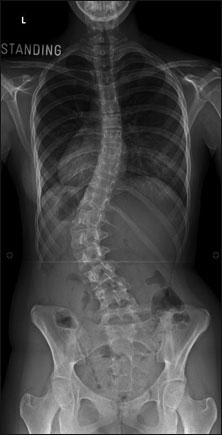Posterior arthrodesis for Lenke 5C AIS associated with excellent curve correction and patient satisfaction
There may be several advantages to correcting Lenke 5C thoracolumbar/lumbar adolescent idiopathic scoliosis with posterior spinal arthrodesis rather than the more traditional method of anterior spinal arthrodesis, investigators found in a study scheduled to be presented at the 15th EFORT Congress – a combined program in partnership with the BOA in London.
Simon Benedict Roberts, MRCS, and colleagues at the Scottish National Spinal Deformity Centre in Edinburgh conducted the largest study of its kind investigating outcomes after posterior spinal arthrodesis (PSA) for treating Lenke 5C thoracolumbar/lumbar adolescent idiopathic scoliosis (AIS) and used a novel unilateral segmental correction technique
Roberts told Orthopaedics Today Europe the study had also identified five radiographic parameters that correlated with the need for distal extension of PSA beyond the caudal Cobb level and used these parameters to develop a predictive equation surgeons can use to reliably inform lowest instrumented vertebra selection.
He said there are three main takeaways from the study results.
“Firstly, Lenke 5C thoracolumbar/lumbar adolescent idiopathic scoliosis can be effectively treated by posterior spinal fusion using pedicle screw instrumentation and a unilateral correction technique...Secondly, the need for extension of the fusion distal to the caudal Cobb level is best guided by five preoperative radiographic parameters,” Roberts said. “Finally, you can incorporate these five parameters into a predictive equation that has an 81% accuracy rate to determine the need for extending a fusion distally or not. This provides supportive and objective information for optimal surgical planning.”

Shown is a preoperative postero-anterior radiograph of the spine of a patient with primary thoracolumbar scoliosis and a compensatory thoracic curve.

This is the same patient’s spine 2 years after posterior spinal arthrodesis. It shows the unilateral segmental pedicle screw correction between the end vertebrae of the thoracolumbar scoliosis.
Images: Roberts SB
The need to correctly determine the lowest instrumented vertebra, Roberts said, is important for the preservation of the distal motion segments and to prevent postoperative spinal imbalance.
For the study, Roberts and colleagues reviewed prospectively collected data for patients treated by Athanasios I. Tsirikos, FRCS, PhD, between November 2006 and August 2011. There were 72 patients who met the inclusion criteria and were followed up for 2 years postoperatively. All patients were diagnosed with thoracolumbar/lumbar AIS and treated with PSA using a unilateral convex segmental pedicle screw technique, according to the abstract.
The mean thoracolumbar/lumbar curve correction was 80%. Subjects also completed SRS-22 questionnaires during the 2-year follow-up to determine their satisfaction, mental health, pain and function. According to the study, PSA using a unilateral convex segmental pedicle screw technique is as effective as anterior spinal arthrodesis and may have some added benefits. For example, the posterior approach results in a more cosmetic scar compared to the anterior approach, Roberts said.
“The unilateral correction technique achieved an excellent curve correction and spine balance, and there was no loss of correction over the two years follow up,” Roberts said. “The method had a high patient satisfaction rate and low complication rates; this was encouraging.”
Roberts said he awaits other surgeons using this novel technique and using the new formula prospectively to determine the need to extend a fusion distally or not, and whether they have similar results in terms of its predictive value.
“It will be interesting to see other surgeons correcting this curve type using the unilateral correction technique and seeing it develop and perhaps become more common,” he said. – by Robert Linnehan
- Reference:
- Roberts SB. Paper #14-2552. Scheduled to be presented June 5 at: 15th EFORT Congress – a combined program in partnership with the BOA; June 4-6, 2014. London.
- For more information:
- Simon Benedict Roberts, MRCS, can be reached at University of Edinburgh, Department of Orthopaedic Surgery, Edinburgh, United Kingdom; email: simonroberts100@hotmail.com.
Disclosure: Roberts has no relevant financial disclosures.
